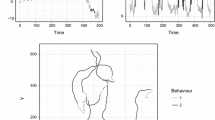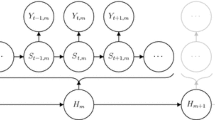Abstract
A Brownian motion whose infinitesimal variance alternates according to a telegraph process is considered. This stochastic process can be employed to model a variety of real-word situations, such as animal movement in ecology and stochastic volatility in mathematical finance. The main goal is to develop an estimation procedure for the underlying model parameters when the process is observed at discrete, possibly irregularly spaced time points. The sequence of observations is not Markov, but the sequence of the state of the telegraph process, if observed, is Markov. The observed sequence is therefore from a hidden Markov model. Likelihood inference is developed via dynamic programming, and is demonstrated to have much higher efficiency than the composite likelihood approach that was applied in an earlier work. The model is applied to model the movement of a mountain lion.
Similar content being viewed by others
References
Beier P, Choate D, Barrett R H (1995) Movement patterns of mountain lions during different behaviors. J Mammal 76:1056–1070
Calenge C (1035) The package adehabitat for the R software: Tool for the analysis of space and habitat use by animals, vol 197
Cane V R (1959) Behavior sequences as semi-Markov chains. J R Stat Soc Ser B 21:36–58
Cappé O, Moulines E, Rydén T (2005) Inference in Hidden Markov Models, vol 6, Springer
Di Crescenzo A, Di Nardo E, Ricciardi L M (2005) Simulation of first-passage times for alternating Brownian motions. Methodol Comput Appl Probab 7:161–181
Di Crescenzo A, Martinucci B, Zacks S (2014) Mathematical and statistical methods for actuarial sciences and finance. In: On the geometric brownian motion with alternating trend Perna C, Sibillo M (eds)
Di Crescenzo A, Pellerey F (2002) On prices’ evolutions based on geometric telegrapher’s process. Appl Stoch Models Bus Ind 18:171–184
Di Crescenzo A, Zacks S (2015) Probability law and flow function of Brownian motion driven by a generalized telegraph process. Methodol Comput Appl Probab 17:761–780
Farmer C, Safi K, Barber D, Martel M, Bildstein K (2010) Efficacy of migration counts for monitoring continental populations of raptors: an example using the osprey (pandion haliaetus). The Auk 127:863–970
Fouque J-P, Papanicolaou G, Sircar R, Sølna k (2011) Multiscale Stochastic Volatility for Equity, Interest Rate, and Credit Derivatives. Cambridge University Press, Cambridge
Horne J S, Garton E O, Krone S M, Lewis S J (2007) Analyzing animal movements using Brownian bridges. Ecology 88:2354–2363
Hornocker M G (1970) An analysis of mountain lion predation upon mule deer and elk in the idaho primitive area, Wildlife Society. Technical Report 21
Jeschke J M (2007) When carnivores are “full and lazy”. Oecologia 152:357–364
Jonsen I D, Flemming J M, Myers R A (2005) Robust state-space modeling of animal movement data. Ecology 86:2874–2880
Kolesnik A D, Ratanov N (2013) Springer Briefs in Statistics Telegraph processes and option pricing. Springer, Heidelberg
Kranstauber B, Kays R, LaPoint S D, Wikelski M, Safi K (2012) A dynamic brownian bridge movement model to estimate utilization distributions for heterogeneous animal movement. J Anim Ecol 81:738–746
Kranstauber B, Smolla M (2013) move: Visualizing and analyzing animal track data. R package version 1.1.360/r365
Lonergan M, Fedak M, McConnell B (2009) The effects of interpolation error and location quality on animal track reconstruction. Marine Mammal Science 25:275–282
Nielson R M, Sawyer H, McDonald T L (2012) BBMM: Brownian Bridge Movement Model. R package version 2.3
Page E S (1960) Theoretical considerations of routine maintenance. The Computer Journal 2:199–204
Patterson T, Thomas L, Wilcox C, Ovaskainen O, Matthiopoulos J (2008) State-space models of individual animal movement. Trends in Ecology and Evolution 23:87–94
Perry D, Stadje W, Zacks S (1999) First-exit times for increasing compound processes. Communications in Statistics: Stochastic Models 15:977–992
Pierce B M, Bleich V C (2003) Wild Mammals of North America, Biology, Management and Conservation. In: Feldhamer G A, Thompson B C, Chapman J A (eds) Mountain lion, 2edn. Johns Hopkins University Press, Baltimore, pp 744–757
Pierce B M, Bleich V C, Chetkiewicz C-L B, Wehausen J D (1998) Timing of feeding bouts of mountain lions. J Mammal 79:222–226
Pozdnyakov V, Meyer T H, Wang Y-B, Yan J (2014) On modeling animal movements using Brownian motion with measurement error. Ecology 95:247–253
Preisler H K, Ager A A, Johnson B K, Kie J G (2004) Modeling animal movements using stochastic differential equations. Environmetrics 15:643–657
Schaller G B, Crawshaw Jr P G (1980) Movement patterns of jaguar. Biotropica 12:161–168
Stadje W, Zacks S (2004) Telegraph processes with random velocities. J Appl Probab 41:665–678
Takekawa J, Newman S, Xiao X, Prosser D, Spragens K, Palm E, Yan B, Li T, Lei F, Zhao D, Douglas D, Muzaffar S, Ji W (2010) Migration of waterfowl in the east asian flyway and spatial relationship to hpai h5n1 outbreaks. Avian Dis 54(s1):466–476
Willems E, Hill R (2009) Predator-specific landscapes of fear and resource distribution: effects on spatial range use. Ecology 90:546–555
Yan J, Chen Y-W, Lawrence-Apfel K, Ortega I, Pozdnyakov V, Williams S, Meyer T (2014) A moving–resting process with an embedded brownian motion for animal movements. Popul Ecol 56:401–415
Yan J, Pozdnyakov V (2016) smam: Statistical Modeling of Animal Movements. R package version 0.3-0
Zacks S (2004) Generalized integrated telegraph processes and the distribution of related stopping times. J Appl Probab 41:497–507
Author information
Authors and Affiliations
Corresponding author
Rights and permissions
About this article
Cite this article
Pozdnyakov, V., Elbroch, L.M., Labarga, A. et al. Discretely Observed Brownian Motion Governed by Telegraph Process: Estimation. Methodol Comput Appl Probab 21, 907–920 (2019). https://doi.org/10.1007/s11009-017-9547-6
Received:
Accepted:
Published:
Issue Date:
DOI: https://doi.org/10.1007/s11009-017-9547-6




